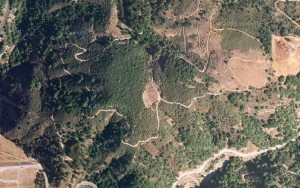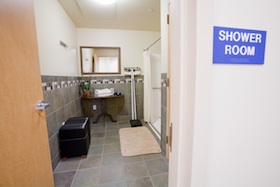You know the feeling. You’ve put in the miles, the hills, the interval training. Now it’s race day and you’re having a good one. You feel balanced, light, and fast. You press the pace one more click and leave another pack of runners behind.
Then it happens. Your foot comes down on a rock and rolls painfully inward. You hear a sickening “pop,” you go down, and the runners you just passed thunder past you. Nauseating pain overwhelms your interest in the torn skin on your hands and stays with you throughout the long limp back to town.
 Here in Los Gatos we’re fortunate to have miles of unpaved recreational trails and utility roads, such as the Los Gatos Creek Trail, the Flume Trail, the Jones Trail, and the Limekiln Trail, offering a variety of terrain through our open space preserves. The race described above could well be our own late-summer annual event, the Dammit Run. If you suffer an ankle sprain while running in competition or in training, here’s what you need to know to get back on the trail and back up to speed.
Here in Los Gatos we’re fortunate to have miles of unpaved recreational trails and utility roads, such as the Los Gatos Creek Trail, the Flume Trail, the Jones Trail, and the Limekiln Trail, offering a variety of terrain through our open space preserves. The race described above could well be our own late-summer annual event, the Dammit Run. If you suffer an ankle sprain while running in competition or in training, here’s what you need to know to get back on the trail and back up to speed.
A Few Definitions
A ligament is a band of fibrous tissue in a joint connecting bone to bone. Each joint has several ligaments. Ligaments are distinct from tendons, which connect muscle to bone. Ligaments support and strengthen joints and make joints stable by limiting joint motion from movements in unwanted directions.
A sprain occurs when a ligament is stretched beyond its normal limits. Sprains are classified according to degrees of severity. A Grade I sprain involves damaging a ligament but not compromising its function of restraining unwanted motion. In a Grade II sprain, the ligament is partially torn and allows some unwanted motion. In a Grade III sprain, the ligament is completely torn and cannot stop unwanted motion, and joint stability and function are lost. Grade III sprains cause diffuse swelling and bruising around the affected joint.
A sprain is more than a simple mechanical injury. Sprains affect proprioception, the neural feedback mechanism that enables us to know the angles of our joints, and the positions of our limbs and extremities, without looking. Good proprioception is what enables us to run in the dark without thinking about where to put our feet, or land a jump shot when focusing on the hoop.
First Aid for Sprains
First Aid for sprains can be remembered by the acronym “RICE,” (Rest, Ice, Compression, Elevation). For Grade I sprains, First Aid treatment alone is often adequate. Grade II and III sprains require rapid administration of First Aid, plus medical evaluation and treatment including some external support, such as a McDavid ankle brace , to protect the ligament while healing. Complete recovery from a Grade II or Grade III sprain is unlikely to occur without medical attention.
Recovery from Sprain
Recovery from a sprain involves promoting the healing of the ligament, elimination of swelling and bruising, increasing strength, and restoring proprioception. At Physical Therapy of Los Gatos the goal of treatment is returning the individual to their pre-injury level of activities and sports, without elevated risk of re-injury. If our runner returns to training on the Los Gatos Creek Trail without fully restored proprioception, he or she will find intense concentration is needed on the exact placement of each foot-fall to prevent the injured ankle from rolling inward again. Longer term, residual changes in joint forces and mechanics, due to incomplete recovery, can accelerate degenerative changes and conditions, such as arthritis.
Restoring Proprioception
Proprioception is based on neural feedback loops that carry and compare information from the eyes and middle ear, and from the stretch receptors of muscles and connective tissues. Following a sprain injury, proprioception is restored by thoroughly rehabilitating neuromuscular control over the affected joint with facilitory techniques such as compression, vibration, and biofeedback. This must be accomplished in a way that promotes, rather than impairs, healing of the injured ligament, and trains the surrounding muscles to assist the injured ligament in supporting the joint while it heals.
Elements of Therapy for Sprain
Therapy begins with a thorough evaluation of the sprain injury. If a Grade III sprain is suspected, the injury should be evaluated by an orthopedic specialist, who will order and evaluate X-ray or MRI images to detect any damage to the underlying bone structure of the affected joint and to obtain a clear picture of soft tissue injuries. Evaluation of a sprain performed by a physical therapist or a physician will also include stress tests to measure the extent of abnormal joint motion caused by the injury, and the progressive tightening of the joint as the injured ligament heals, as compared to the stress-bearing characteristics of the opposite joint and normative values.
In addition to specific, individualized strengthening exercises aimed at re-establishing neuromuscular control and joint strength, physical therapy for sprain should also include evaluation and training of muscles affecting the entire limb of the injured joint. For instance, when ankle pain, weakness, or injury compromise proprioceptive cues, the hips and low back muscles will compensate by altering the injured individuals’ walking and running patterns. Because the goal of therapy is complete recovery, including normal or improved function, specific, progressive exercises are prescribed over the course of rehabilitation to restore motion, strength, and control throughout the entire limb.
If you suspect you have a joint injury involving ligament sprain, please contact us for expert advice by calling (408) 358-6505. For additional information about ankle sprain, see the related article “Foot and Ankle Injuries of Ballet Dancers.”

Comments on this entry are closed.